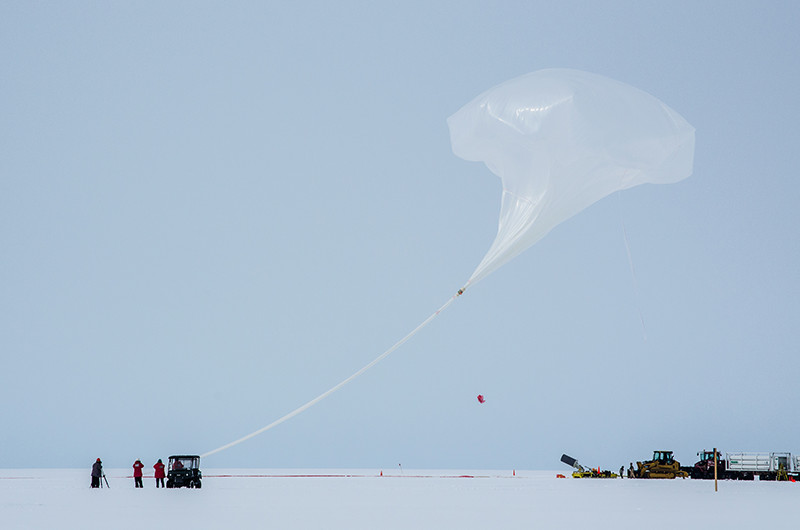
Photo Credit: Mike Lucibella
|
Inclement weather delayed the launch of GRIPS and scrubbed several launch attempts.
|
The Best Vantage Point
By Michael Lucibella, Antarctic Sun Editor
Page 3/4 - Posted October 5, 2016
For 12 days, GRIPS drifted around the continent collecting data with its eight-meter-long boom fixed on the sun. Suspended high above the Antarctic Continent gave the researchers an uninterrupted view of our closest stellar neighbor, one that can’t be replicated nearly anywhere else on Earth.

Photo Credit: Mike Lucibella
On the morning of January 19, despite overcast skies, the launch crew brought the scientific payload and balloon down to the balloon field for launch.
“Antarctica is a great place. Because we’re a solar mission, we want to observe the sun the whole time. In Antarctica, in the summer, we have the sun 24 hours a day,” said Saint-Hilaire. “It’s kind of a natural fit.”
At about 24 miles above the surface, the telescope floated above approximately 99.7 percent of the planet’s atmosphere, affording it a nearly pristine view of the sun.
“We are looking at very high-energy light, and that’s the reason why we have to be on a balloon, because hard X-rays and gamma rays don’t really penetrate the atmosphere,” Duncan said. “That’s why we have to get above 100,000 feet, as high as we can get really, in order to collect that light.”
Reaching that altitude is no easy feat. It takes two-thirds of a ton of helium to lift the two ton instrument to its cruising altitude. The team had to weather numerous launch delays while they waited for the perfect windless conditions to launch the house-sized balloon. Then once it was in the air, it presented unique challenges over more traditional telescopes.

Photo Credit: Mike Lucibella
The 150-foot-tall helium balloon carrying GRIPS lifts off from the long duration balloon field.
“A ground-based telescope, you can always go into it and change things,” Duncan said. “You can turn it on and if it doesn’t work or if it’s having a bad day you can always go change it, whereas here it has to work and it has to work the first time, so we have to do a lot of testing and a lot of analysis and then we launch it.”
Unlike conventional optical telescopes, GRIPS had no lenses or mirrors. Gamma rays pass through glass unaffected, so lenses and mirrors wouldn’t be able to focus the incoming signal. Instead, at the front of GRIPS’ eight-meter-long rectangular boom was a round metal disk.
“At the front of the boom you got a grid that actually rotates. This grid has slits and slats,” Saint-Hilaire said.
The sun’s gamma rays pass through these tungsten slits onto the germanium detectors at the far end of the boom. The detectors record the path of every photon that seems to originate from near the sun. Because of these slits, the detector only sees a pattern of stripes in any given moment. But an instant later, a slightly different striped pattern appears as the grid rotates at about 10 times a minute. When the researchers then stitch all of those individual images together, these stripes resolve themselves into a coherent image pinpointing the origin of the gamma rays.
“You just add those probability maps together, and in the end you will get the brightest spot exactly where the source is,” Saint-Hilaire said.
Previous
1
2
3
4
Next







